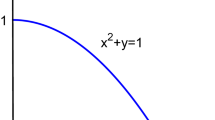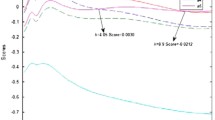Abstract
A (p, q)-fuzzy set is the resulting structure when the fuzzy membership and non-membership values are bounded by a general nonlinear relation. This set enhances the range of depicting uncertain information by making the feasible region larger, and thereby widening the purview of decision-making. Data aggregation is crucial in optimal decision-making. This article attempts to formulate aggregation operators for (p, q)-fuzzy sets using additive generators of strict t-norms and strict t-conorms. The utility of these operators is showcased by examining a decision-making problem, where the best decision is obtained by ranking the alternatives based on their score values. A comparative study is also carried out using some existing aggregation operators to test the validity and effectiveness of the introduced operators.





Similar content being viewed by others
Abbreviations
- AO:
-
Aggregation operator
- FFS:
-
Fermatean fuzzy set
- IFS:
-
Intuitionistic fuzzy set
- MADM:
-
Multi-attribute decision-making
- n,m-ROFS:
-
n,m-Rung orthopair fuzzy set
- n,m-ROFWPA:
-
n,m-Rung orthopair fuzzy weighted power average
- PFS:
-
Pythagorean fuzzy set
- (p, q)-FS:
-
(p, q)-Fuzzy set
- (p, q)-FWA:
-
(p, q)-Fuzzy weighted averaging
- (p, q)-FWG:
-
(p, q)-Fuzzy weighted geometric
- (p, q)-FEWA:
-
(p, q)-Fuzzy Einstein weighted averaging
- (p, q)-FEWG:
-
(p, q)-Fuzzy Einstein weighted geometric
- (p, q)-FHWA:
-
(p, q)-Fuzzy Hamacher weighted averaging
- (p, q)-FHWG:
-
(p, q)-Fuzzy Hamacher weighted geometric
- q-ROFS:
-
q-Rung orthopair fuzzy set
References
Al-shami, T.M., and A. Mhemdi. 2023. Generalized frame for orthopair fuzzy sets:(m, n)-Fuzzy sets and their applications to multi-criteria decision-making methods, Information, 14(1): 56.
Atanassov, K.T. 1999. Intuitionistic fuzzy Sets: theory and applications. Physica-Verlag HD.
Beliakov, G., H. Bustince, D.P. Goswami, U.K. Mukherjee, and N.R. Pal. 2011. On averaging operators for Atanassov’s intuitionistic fuzzy sets. Information Sciences 181 (6): 1116–24.
Beliakov, G., Pradera, A., Calvo, T. 2007. Aggregation functions: a guide for practitioners, Vol. 221. Springer.
Calvo, T., Mayor, G., Mesiar, R. 2002. Aggregation operators: new trends and applications, Vol. 97. Springer Science & Business Media.
Darko, A.P., and D. Liang. 2020. Some q-rung orthopair fuzzy Hamacher aggregation operators and their application to multiple attribute group decision making with modified EDAS method. Engineering Applications of Artificial Intelligence 87: 103259.
Garg, H. 2016. A new generalized pythagorean fuzzy information aggregation using einstein operations and its application to decision making. International Journal of Intelligent Systems 31 (9): 886–920.
Grabisch, M., Marichal, J.L., Mesiar, R., Pap, E. 2009. Aggregation functions, Vol. 127. Cambridge University Press.
Hadi, A., W. Khan, and A. Khan. 2021. A novel approach to MADM problems using Fermatean fuzzy Hamacher aggregation operators. International Journal of Intelligent Systems 36 (7): 3464–3499.
Huang, J.Y. 2014. Intuitionistic fuzzy Hamacher aggregation operators and their application to multiple attribute decision making. Journal of Intelligent & Fuzzy Systems 27 (1): 505–513.
Ibrahim, H.Z., and I. Alshammari. 2022. n, m-rung orthopair fuzzy sets with applications to multicriteria decision making. IEEE Access 10: 99562–99572.
Ibrahim, H.Z., T.M. Al-Shami, and O.G. Elbarbary. 2021. \((3, 2)\)-fuzzy sets and their applications to topology and optimal choices. Computational Intelligence and Neuroscience 2021: 1272266.
Klement, E. P., Mesiar, R., Pap. E. 2013. Triangular norms, Vol. 8. Springer Science & Business Media.
Liu, P., and P. Wang. 2018. Multiple-attribute decision-making based on Archimedean Bonferroni operators of q-rung orthopair fuzzy numbers. IEEE Transactions on Fuzzy systems 27 (5): 834–848.
Maes, K.C., S. Saminger, and B. De Baets. 2007. Representation and construction of self-dual aggregation operators. European Journal of Operational Research 177 (1): 472–487.
Rani, P., and A.R. Mishra. 2021. Fermatean fuzzy Einstein aggregation operators-based MULTIMOORA method for electric vehicle charging station selection. Expert Systems with Applications 182: 115267.
Senapati, T., and R.R. Yager. 2020. Fermatean fuzzy sets. Journal of Ambient Intelligence and Humanized Computing 11 (2): 663–674.
Wang, W., and X. Liu. 2012. Intuitionistic fuzzy information aggregation using Einstein operations. IEEE Transactions on Fuzzy Systems 20 (5): 923–938.
Wu, S.J., and G.W. Wei. 2017. Pythagorean fuzzy Hamacher aggregation operators and their application to multiple attribute decision making. International Journal of Knowledge-Based and Intelligent Engineering Systems 21(3): 189–201.
Xia, M., Z. Xu, and B. Zhu. 2012. Some issues on intuitionistic fuzzy aggregation operators based on archimedean t-conorm and t-norm. Knowledge-Based Systems 31: 78–88.
Xu, Z., and Q.L. Da. 2003. An overview of operators for aggregating information. International Journal of intelligent systems 18 (9): 953–969.
Yager, R.R. 2013. Pythagorean fuzzy subsets. In 2013 joint IFSA World congress and NAFIPS annual meeting (IFSA/NAFIPS), pp. 57–61.
Yager, R.R. 2013. Pythagorean membership grades in multicriteria decision making. IEEE Transactions on Fuzzy Systems 22 (4): 958–965.
Yager, R.R. 2016. Generalized orthopair fuzzy sets. IEEE Transactions on Fuzzy Systems 25 (5): 1222–1230.
Yang, Y., Kwai-Sang Chin, Heng Ding, Hong-Xia Lv, and Yan-Lai Li (2019.U) Pythagorean fuzzy bonferroni means based on t-norm and its dual t-conorm. International Journal of Intelligent Systems 34 (6): 1303–1336.
Zadeh, L.A. 1965. Fuzzy sets. Information and Control 8 (3): 338–353.
Acknowledgements
The first author gratefully acknowledges the financial assistance from the Ministry of Education of the Government of India and the National Institute of Technology Calicut during the preparation of this paper.
Author information
Authors and Affiliations
Corresponding author
Ethics declarations
Conflict of interest
All authors declare that they have no conflict of interest.
Additional information
Communicated by S Ponnusamy.
Publisher's Note
Springer Nature remains neutral with regard to jurisdictional claims in published maps and institutional affiliations.
Appendix A
Appendix A
Rights and permissions
Springer Nature or its licensor (e.g. a society or other partner) holds exclusive rights to this article under a publishing agreement with the author(s) or other rightsholder(s); author self-archiving of the accepted manuscript version of this article is solely governed by the terms of such publishing agreement and applicable law.
About this article
Cite this article
Sivadas, A., John, S.J. & Athira, T.M. (p, q)-fuzzy aggregation operators and their applications to decision-making. J Anal (2024). https://doi.org/10.1007/s41478-023-00693-1
Received:
Accepted:
Published:
DOI: https://doi.org/10.1007/s41478-023-00693-1




